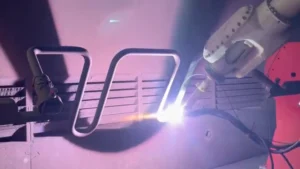table of contents
- Heading 1
- Heading 1
- Heading 1
- What Is Robotic Sanding?
- What Is Robotic Polishing?
- The Evolution of Sanding and Polishing Processes
- Automating Sanding and Polishing Processes Using Industrial Robots
- Benefits of Automated Sanding & Polishing
- 5 Key Technologies in Automated Sanding and Polishing
- Which Industries Are Automating Sanding & Polishing Processes?
- Sanding Case Study: Pioneer Industrial Systems
- Automated Polishing Case Study: Paradigm Electronics
- Using Augmentus’ Robotic Sanding & Polishing for Surface Treatment Applications
- About Augmentus
- References
share this
Sanding and polishing applications are used commonly in many manufacturing processes, including those in the automotive and aerospace industries. As technology improves, companies are looking to automate robots and integrate them into their processes. Compared to the past, robots are now equipped with sensors that can detect visual and tactical input. Factories are now able to go lights-out without worrying about any interference, improving efficiency.
What Is Robotic Sanding?
Robotic sanding solutions are fully automated systems in which industrial robots are fitted with sanding end of tools. They use controlled force in sanding tasks and work at a constant speed to ensure uniform output. It further uses sensor and vision systems to monitor the surface irregularities and align the robot’s motion for an even finish. This automation not only increases productivity and quality but also minimizes exposing workers to dust-related diseases and repetitive strain injuries.
What Is Robotic Polishing?
Robot polishing is a process of polishing surfaces using robots to achieve first-class finishes. Parts are polished using polishing end effectors and advanced sensors that apply the required amount of pressure. These robots also move along the surface to achieve the required surface smoothness. This involves the use of abrasives in multiple cycles and could be accompanied by vision systems to achieve consistency. Robot polishing reduces manpower, and errors while increasing productivity.
The Evolution of Sanding and Polishing Processes
Early Methods
In the 19th century, cleaning and finishing the floor involved rudimentary sanding and polishing methods. They often used tools such as sandpapers that were bound to the handles of the brooms. The techniques used before were more time-consuming, not very dependable, and caused inequalities in the finishes obtained.
Mechanization
Mechanized sanding and polishing tools were much better when brought into the process. Tools such as belt sanders and rotary polishers enhanced efficiency and offered better outcomes when compared to traditional techniques. These tools minimized the energy used by the workers and made their lives easier.
Automated Systems
The current world has seen fully automated sanding and polishing systems. These tasks are done by robots having better sensors, force control, and vision systems. These automatic systems have helped the manufacturing industries increase production, standardization, and reduce fatality among employees. The introduction of 3D scanning and motion planning has helped robots work on complex shapes and surfaces
Automating Sanding and Polishing Processes Using Industrial Robots
Sanding and Polishing
Sanding and polishing are material removal applications that involve applying an abrasive onto a surface of an object thereafter refining it to achieve a smooth, clear surface. The manual process of surface treatments is hazardous, leaving the safety of workers at risk as they are exposed to dust and debris. It is also a labour-intensive and time-consuming process.
Polishing and sanding differ in their spin rate. An orbital polishing end effector spins at a lower rate to prevent the burning of the workpiece through the heat generated.
Automated sanding robots commonly come with accessories such as an orbital sander end effector, a vision system, and force sensors, allowing manufacturers to achieve consistency and quality assurance on their workpieces. Automated sanding robots can operate much faster than humans and improve cycle times and productivity.

Automated Sanding end effector by onRobot. Image by onRobot
Benefits of Automated Sanding & Polishing
Automation in sanding and polishing offers various benefits. Let’s discuss the most important ones.
Enhanced Productivity
Automated sanding and polishing reduce time and enhance work rates. They are continually operational and can work at higher speeds compared to a manual workforce. Since they don’t get tired, they make production quick and constant.
Consistent Quality
Automation helps with uniformity and consistent quality in the finishing processes. They follow a given pattern and path and apply an appropriate amount of pressure on the workpiece. This allows robots to get a perfect surface finish on all the jobs, unlike manual work.
Improved Worker Safety
Sanding and polishing when automated have a minimal or near-zero chance of exposing workers to dust and vibrations, and other work-related injuries such as RSIs (Repetitive Strain Injury). This means that robots can accomplish these activities in areas that are risky for human employees. This improves the general safety of workplaces.
Cost Efficiency
Even though setting up automated systems requires large amounts of initial investment, the performance gains are excellent in the long run. Cutting down on the need for labor cuts down on the wastage of materials and makes processes faster. This reduces the operational costs in the long run. There is also less occurrence of errors which again helps to cut costs.
Scalability and Flexibility
Automated sanding and polishing systems are flexible. This makes it very easy for manufacturers to change their production scale and process. These systems can be reprogrammed to suit certain tasks and new products.
5 Key Technologies in Automated Sanding and Polishing
Automated sanding and polishing machines use the below-discussed 5 fundamental technologies. All these are significant in their own right and thereby make them inevitable in modern manufacturing:
Industrial Robot Sanding and Polishing
Sanding and polishing operations are performed by industrial robots with their respective end effectors for superior-quality surface finishes. These robots move in set patterns and apply definite force to specific pieces of the work. They can run without interruptions, which increases efficiency and decreases the risks of errors.
3D Scanning and Motion Planning
3D scanning technology generates intricate point clouds of objects and allows accurate motion planning for robots. Robots can navigate the sanding and polishing path on the object based on its shape and surface properties. This minimizes the cycle times and guarantees proper surface coverage.
Force Control and Feedback Systems
These systems are essential to maintain the necessary pressure while sanding as well as while polishing. They constantly check the pressure being applied by the robot depending on the texture and firmness of the surface area. This adjustment is also mostly crucial in avoiding harming sensitive surfaces.
Vision Systems
A vision system uses cameras and sensors to allow the robots to identify any flaws and modify their behavior in the process. They guide robots to sense surface flaws, like scratches or unevenness, and adjust their sanding or polishing plans. This saves time and costs that would have been used in manual inspections. However, such vision systems need AI accompaniment. The vision systems in the market are mainly used for part identification in high-mix productions and detecting part-to-part deviations caused by factors like warpage.
Collaborative Robots (Cobots)
Cobots are robot systems built to collaborate with human operators for increased dexterity and usability. They are equipped with force-limited joints and proximity sensors as a safety measure. Their programming structures allow for easy switching between tasks because of their simplicity. This makes them suitable for SMEs that need equipment with an element of flexibility.
Which Industries Are Automating Sanding & Polishing Processes?
Sanding and polishing are gradually being incorporated into various fields as a means of saving time and efficiency of the work. Automotive manufacturing applies these technologies in the final shaping of body systems and auto parts.
Currently, aerospace equipment producers use automated systems for their safety and performance. In the woodworking industry, automation is essential for generating a smooth surface on furniture and flooring. Further, electronics and consumer industries also apply automated polishing to attain a higher surface finish and nicer looking products.
Sanding Case Study: Pioneer Industrial Systems
Problem
Pioneer Industrial Systems is a company based in the US that provides turn-key robotic solutions for various applications and industries. One of their clients, an engineer of plastic molding and surface treatment for automotive industries required a solution to replace their existing sanding system, which was labour-intensive and unsafe. The orbital sander was bulky and users risk getting exposure to abrasive dust particles.

Automated Sanding Workcell using FANUC M710iC. Image by Pioneer Industrial Systems
Solution
As a system integrator, Pioneer had experience in designing turn-key solutions that leveraged robotic and PLC (Programmable Logic Controller) programming. In this case, the client required a versatile solution that could sand a variety of objects as the automotive industry consists of high mixed assemblies. Pioneer designed a cell that could support the sanding of different parts of a vehicle and the underside of those parts. The end effector chosen had a pressure-sensing technology that provided dust containment at the source. After determining the reachability and payload considerations, FANUC M710iC was chosen as the robot of choice. As a result of this implementation, the workplace experienced improved air quality and efficiency.

Polishing End effector on display at Automatica. Image by Robotiq
Automated Polishing Case Study: Paradigm Electronics
Problem
Paradigm Electronics is a manufacturer of subwoofers and speakers. The audio manufacturing industry is extremely labour-intensive and is constantly on the lookout for automation solutions. In this case study, the company is faced with the challenge of polishing and buffing new cabinets. This application required multiple layers of lacquer to be applied and the process required a few cycles of sanding and buffing. Prior to this, the company had already implemented a robotic cell, but it had safety concerns due to the proximity of the robot arm and its operators.

UR cobot engaged in surface treatment for one of Paradigm Electronics’ cabinets. Image by Universal Robots and Paradigm Electronics
Solution
Working with Universal Robots has allowed Paradigm Electronics to create a robotic cell using collaborative robots. UR cobots have an inbuilt adjustable force mode that allows operators to customize the force applied on surfaces. This is extremely vital for polishing applications as applying too much force may result in overheating of the surface and achieve undesirable results. In addition, this feature helps the company to save on cost as force feedback systems in the market are expensive. Furthermore, with a UR cobot, operators are able to safely interact with it directly and check for the quality of work before any finishes.
Using Augmentus’ Robotic Sanding & Polishing for Surface Treatment Applications
Given the increase in demand for robotic sanding solutions for surface treatment applications, Augmentus has added a polishing end effector to its line of integrated end effectors within the platform. Augmentus enables non-technical operators to automate their sanding processes in minutes, without the need for coding and CAD files. Users digitize their robot cells in seconds, and our intelligent algorithms will automatically generate optimized robot sanding paths while taking into account force control, constant velocity, and logic.
About Augmentus
Augmentus pioneers industry-leading robotic technologies that enable easy and rapid robotic automation, enabling anyone, even those with no robotic experience, to program dynamic industrial robots in minutes. Our proprietary technology incorporates algorithms to enable fully automated robot path generation and an intuitive graphical interface that eliminates the need for coding and CAD files in robot teaching. Companies using Augmentus have experienced up to 70% cost reduction and 17 times faster deployments across a wide variety of applications, such as spraying, palletizing, welding, and inspections. Augmentus ushers in a new era of human-machine interface, democratizing robotic automation.
Discover how Augmentus’ cutting-edge robotic sanding & polishing solution can transform your surface treatment processes. Schedule a demo today!
References
- [1] Polishing Robots
- https://robotsdoneright.com/applications/polishing-robots.html
- [2] Robotic Sanding Cell Case Study
- https://pioneer.infostreamhosting.com/case-studies/robotic-sanding-cell-case-study/[3] Case Stories: Paradigm Electronics
- https://www.universal-robots.com/case-stories/paradigm-electronics/




